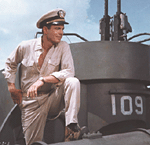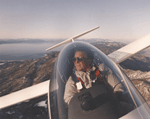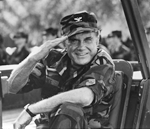|
The Celebrity Collector
Cliff Robertson Collects
Vintage Aircraft
By Ken Hall
It's probably difficult for most people
to put their arms around (literally and figuratively!) a collection
as unusual and gigantic as vintage aircraft. But when you've got the
name, resources and passion for flying that Cliff Robertson has, it
all makes perfect sense. Robertson's love of aircraft and flying far
predate his involvement in acting (which led to an Oscar for the
film Charly in 1968).
Robertson was born in La Jolla, Calif.,
in 1925, the scion of a prosperous California ranching family. As a
boy of about 13, he'd hop on his bike to make the 13-mile ride to
Speer Airport in San Diego (no longer in existence), just to watch
the planes take off and land. He was a self-described "airport rat,"
one of a group of like-minded boys whose imaginations took flight in
easier, lazier times.
"In the summer, I'd ride my bike there
six days a week and volunteer to clean planes and grease engines for
zero money," Robertson remembered from his home near Southampton,
Long Island. "The payoff came once a week, when the chief pilot
would take me up in a little Taylor Cub for a fifteen-minute ride.
That made it all worthwhile. I never dreamed of one day owning a
plane."
Make that four planes, actually, and that
represents a downsizing, considering the "Robertson air force"
formerly included a Spitfire Mark 9 and three Tiger Moths, all of
which have been sold. The current fleet includes a French Stampe, a
Messerschmitt, a Grob Astir glider and a Beech Baron. If these names
all read like high-flying Greek, a few words of explanation about
each will be of help:
- French Stampe - This is a biplane that
is actually Belgian in origin. It first flew in 1933 as a training
airplane, but after World War II its construction was taken over
by France and the "Societee Nationale de Construction Aeronautique
du Nord" (SNCAN). About 700 were made. It's one of those rare
airplanes that was rarely "junked," but bought and lovingly
restored by collectors like Robertson.
- Messerschmitt 108 - A four-seater
executive liaison military aircraft, developed in the 1930's by
the Germans for the Luftwaffe (German Air Force). The plane was
advanced for its time, with retractable landing gear, an enclosed
cockpit and cantilevered wings. It was used to transport
high-ranking German military brass. A cousin craft, the 109, was a
one-seater, short-range fighter plane.
- Grob Astir - This is a two-place
(two-person) fiberglass glider -- no engine! One has to be towed
for takeoff and, without the benefit of jet propulsion or internal
combustion, a pilot must be shrewd and skilled to fly one.
Robertson is both. In fact, he holds the distance soaring record
in Nevada for that class of plane, having glided 240 miles in the
'90s -- with a 6'4" passenger aboard!
- Beech Baron - This isn't a vintage
aircraft at all, but it is one of Robertson's favorite toys. "I
fly it along the East Coast to get to speaking engagements,
scouting locations, that sort of thing," he said. The Baron is a
modern, executive propeller plane, with leather seats and twin
fuel-injected engines. Robertson keeps his in a nearby hanger on
Long Island, where he can hop in and take off.
The aircraft Robertson once owned but has
since sold include:
- Supermarine Spitfire Mark IX - The
most famous military aircraft of all time and one of the most
beautiful ever built. It went up against the vaunted Messerschmitt
during World War II and beat back the German threat in the Battle
of Britain. By the time production ceased in 1949, over 22,000
Spitfires (and Seafires) had been made. Robertson sold his after
getting "an offer I couldn't refuse."
- Tiger Moth - The designer of this
British, two-seater biplane -- Sir Geoffrey de Havilland -- was an
entomologist and named several of his aircraft designs after
moths. The first Tiger Moth was tested in 1934. When World War II
broke out, it proved invaluable as a trainer. One heart-stopping
feature: no brakes! The tail component had a skid, which slowed it
down in grass training fields.
In 1969, Charles Lindbergh flew one of
Robertson's Tiger Moths at Santa Paula (Calif.) Airport, where
Robertson keeps another hanger (there's a third one as well, in
Creve Coeur, Mo.). "He made his flight log entry that day, just like
an ordinary pilot," he said. Robertson later narrated a film shown
at the Smithsonian Institute commemorating the anniversary of
Lindbergh's historic flight.
"Flying is freedom," Robertson once said.
"It's the essence of the good life." But, he added, "There's
synergism in an activity like aviation. You must give back what you
take out." And those aren't just words. In 1969, when a civil war
was raging in Nigeria, Robertson helped organize an effort to fly
food and medical supplies into Biafran, which was caught in the
middle of the conflict.
Then, in 1978, when a famine hit
Ethiopia, Robertson organized flights of supplies to this ravaged
country. Four years later, he received the L.P. Sharples Award from
the Aircraft Owners and Pilots Association for his many
contributions to aviation. He's been honored by the U.S. Air Force,
the National Soaring Museum and the National Aviation Club. He often
speaks at aviation programs.
In the '80s, Robertson decided to put to
test the legend of Gustave Whitehead, the German immigrant who
supposedly built and flew an airplane in Bridgeport, Conn., in 1901
-- two years before the Wright Brothers. Robertson rebuilt
Whitehead's craft and piloted it himself down a runway in
Bridgeport. It lifted off the trailer holding it and briefly took
flight, lending credence to the story.
"We'll never take away the rightful role
of the Wright Brothers," Robertson said, "but if this poor little
German immigrant did indeed get an airplane to go up and fly one
day, then let's give him the recognition he deserves." These remarks
are consistent with Robertson's on-screen persona. He's often
depicted as solid-looking, intense and earnest; an intelligent and
reliable 'Everyman.'
But acting wasn't an early ambition. "I
acted in class plays to get out of having to do after-school
chores," he confessed. When he enrolled at Antioch College in Ohio,
it was to pursue writing. He got a job on the town paper, where
someone said his writing style would be better suited for the
theatre. Robertson liked the idea, but all plans were put on hold
with the outbreak of World War II.
Robertson figured he'd be a natural as a
Navy pilot, but when one of his eyes tested at less than 20-20, he
was forced to take another route. He joined the maritime service --
the Merchant Marine -- and saw action in the South Pacific, the
Mediterranean, the North Atlantic and France. "It was a dangerous
way to spend the war," he said, "but I'm still here. Not everybody
was so lucky."
Back in civilian life, Robertson went to
New York to pursue his dream of writing for the theatre. He fell
into acting "because it was there and it was something I could do."
He got a break in 1950 when he joined a national touring company for
the play "Mister Roberts." That lasted two years. Then, he was cast
on Broadway in Joshua Logan's "The Wisteria Trees," with Helen
Hayes.
In 1955, Robertson made his screen debut
in the Logan-directed movie version of "Picnic." That same year he
drew praise as Joan Crawford's schizophrenic boyfriend in "Autumn
Leaves." In 1963 he was hand-picked by then-President Kennedy to
portray him in the World War II action bio-pic "PT 109." In 1965,
Robertson earned an Emmy award for his role in the TV play "The
Game."
Robertson copped acting's highest prize
in 1968 when he won an Oscar for the lead role in "Charly," in which
he played a retarded adult who is given temporary intellectual
powers following a scientific experiment. In all, he's been in about
70 movies, recently as Tobey Maguire's Uncle Ben in "Spiderman"
(he'll also be in the sequel). He just finished work on Stephen
King's "Riding the Bullet."
Robertson has two daughters -- Stephanie
and Heather -- the latter by actress Dina Merrill, to whom he was
married for 22 years but is now divorced. The two appeared opposite
one another in the campy '60s television hit "Batman." He is
actively involved in many charities and organizations not related to
aviation. Fans of Cliff Robertson may visit the star online at http://www.cliffrobertson.net./
2004
|

Then-President John F.
Kennedy hand-picked Robertson to play him in the 1963 bio-pic "PT
109."

Robertson flies high in
his Grob Astir glider -- no engine! He holds a state distance record
(240 mi.).

Robertson plays
square-jawed, dependable types, like in this publicity still from
"Renaissance Man."

That's Robertson in the
cockpit of his Spitfire, flying over Montreal and escorted by a
Canadair jet.
|